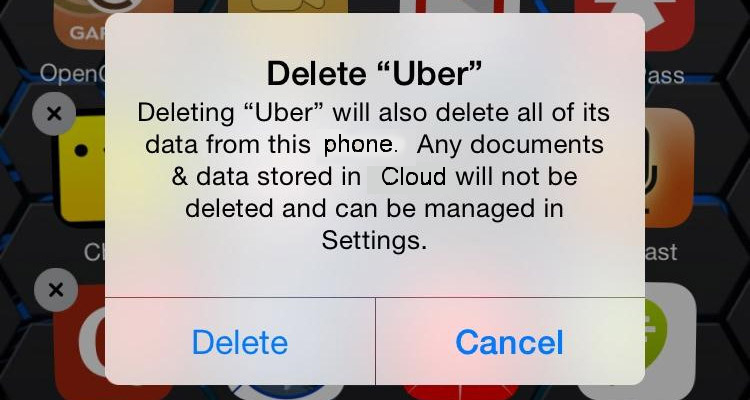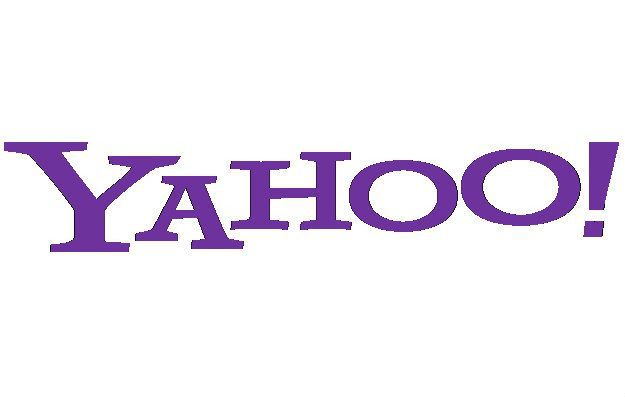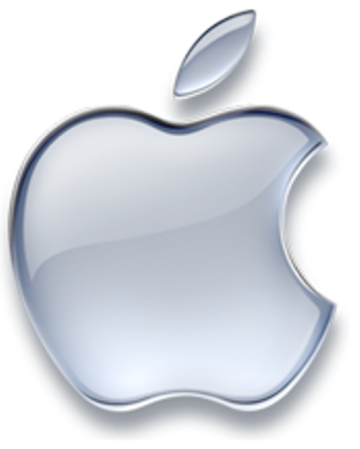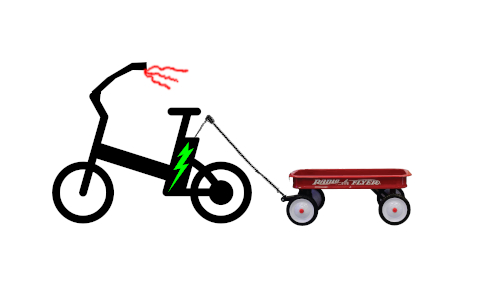
by Adam Hartung | Jun 10, 2021 | Entrepreneurship, In the Rapids, Innovation, Strategy, Transportation, Trends
The Slow Decline of Two Famous Brands
Demographics have been causing the slow death of 2 very famous brands. Radio Flyer and Harley-Davidson. Now they are reacting, and maybe it won’t be too little too late for them. Here’s the story and a small dose of innovation theory for you to implement in your business.
Radio Flyer for 100 years has been famous for its little red wagons. Since before the Great Depression, children have enjoyed these wagons (and scooters, etc.) for recreation. But family formation has fallen precipitously the last decade, and the birth rate has fallen even faster. Further, lots of competitors have entered the market for small pull wagons and scooters. The net impact is fewer babies, and a big drop in demand for the traditional metal wagons. For a company manufacturing in Chicago, it looked like another slow slide into irrelevancy and failure.
But now, Radio Flyer has announced its new e-bike and e-scooter products. This opens the door to an entirely new market and new customers. People of all ages have started purchasing e-bikes. They ride for pleasure, to run errands and even commuting. In some cities, electric scooter ride sharing rentals have soared faster than bicycle rentals. Sales have skyrocketed. Seeing the underlying trend in demographics, and the changing consumer behavior Radio Flyer is entering the market with new products – priced squarely in the market sweet spot – which just might make the company relevant again.
An even older company is Harley-Davidson. For years, Harley has dominated the market for large engine cruiser style motorcycles. In the 1970s and 1980s, this served the company well as motorcycle sales grew and customers would up-size to Harley bikes from smaller Japanese manufacturers. But the brand image wore old a long time ago. Images of “Hells Angels”, “Easy Rider” and accountants turned HOG (for Harley Owners Group) were not attractive to younger buyers. The average age of Harley buyers kept rising, until now it is almost 60 years old! The reality is that Harley’s market simply started dying off, aging out of buying new motorcycles (or any motorcycle for that matter.) And younger buyers were far less interested in the old-style cruiser in favor of the smaller sized, easier handling and mostly faster sport bikes made in Japan.
For years Harley-Davidson ignored the demographic trends and the impact on its business. Harley made an effort to update its product, and image, introducing the V-Rod with a Porsche manufactured engine. But dealers didn’t like it, and Harley never put in the promotion to bring in the new, younger rider the bike was designed to attract. Now, Harley-Davidson has launched its own e-bike, called the Serial 1. At $5,000 it’s a top-priced e-bike, I guess aligned with the company reputation for premium pricing. But the Serial 1 has garnered good reviews, and like the Radio Flyer e-bike it gives Harley a new technology and a new market with new customers. And most important, a chance to slow its slide into irrelevancy.
Will these products turn these companies around?
It’s hard to say. They aren’t creating a new market like Netflix did in streaming, or Apple did with apps on iPhones. They aren’t early to market. One could say they are a late entry into a crowded marketplace. And neither appear to be introducing any new technology, or enhanced functionality not already available. And the brands are outdated, loaded with nostalgia – which might be good, or bad. But at least they are reacting to trends.
Innovation Theory in Practice
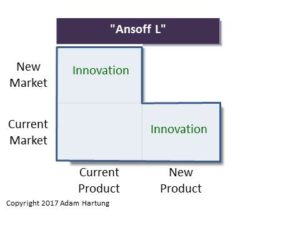 Both Radio Flyer and Harley-Davidson have responded to trends by introducing electric personal transportation products. Both also have loyal core customer segments and strong brand awareness in non-customer segments. The new products allow both companies to launch to existing customers which is the lowest risk choice because the segments are well-known. From there, the brands can expand to new customer segments via word-of-mouth, visibility and ad campaigns. This follows the Ansoff matrix from Current Market/New Product to New Market/New Product.
Both Radio Flyer and Harley-Davidson have responded to trends by introducing electric personal transportation products. Both also have loyal core customer segments and strong brand awareness in non-customer segments. The new products allow both companies to launch to existing customers which is the lowest risk choice because the segments are well-known. From there, the brands can expand to new customer segments via word-of-mouth, visibility and ad campaigns. This follows the Ansoff matrix from Current Market/New Product to New Market/New Product.
The second issue is that the market for electric personal transportation is past Early Adopters and into the Growth stage which is when new brands jump in and the market starts to fragment. There is plenty of market share for both Radio Flyer and Harley-Davidson to become established. One key question is- Can these brands offer the products and brand desire to make the jump to segments of new customers?
Are the Brands Structured to Succeed?
To succeed, they must COMMIT resources and focus to these new markets, and create new developments. I wish they would have launched with White Space teams that had permission to develop a new brand image, new distribution, new ad campaigns – an entirely new approach designed to seek out market leadership. Harley-Davidson did create a version of a “skunkworks” with the spinoff of Serial 1, LLC. For now the PR sounds more like they are doing it “on the sly” as something they aren’t really sure will succeed. So it’s really up to senior leadership now. They either commit to a new future allowing product teams to build on the e-bike opportunity to develop new technology, new customers and new markets – or they can slip back into the slide downward. We’ll have to wait and see if they can jump the re-invention gap.
Did you see the trends, and were you expecting the changes that would happen to your demand? It IS possible to use trends to make good forecasts, and prepare for big market shifts. If you don’t have time to do it, perhaps you should contact us, Spark Partners. We track hundreds of trends, and are experts at developing scenarios applied to your business to help you make better decisions.
TRENDS MATTER. If you align with trends your business can do GREAT! Are you aligned with trends? What are the threats and opportunities in your strategy and markets? Do you need an outsider to assess what you don’t know you don’t know? You’ll be surprised how valuable an inexpensive assessment can be for your future business. Click for Assessment info. Or, to keep up on trends, subscribe to our weekly podcasts and posts on trends and how they will affect the world of business at www.SparkPartners.com
Give us a call or send an email. Adam@sparkpartners.com 847-726-8465.
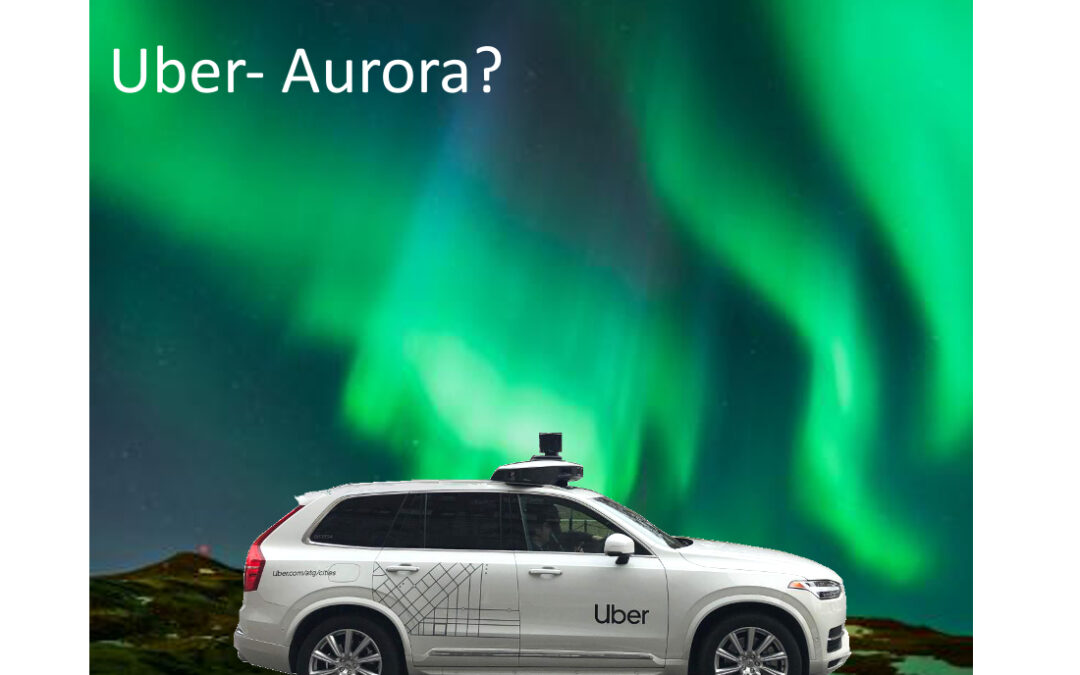
by Adam Hartung | Dec 22, 2020 | eBooks, Innovation, Investing, Strategy, Transportation, Trends

Thrive to the Future – 4 top trends for 2021 and beyond.
On December 7, Uber announced it is spinning out its autonomous car development effort to a new company- Aurora. On December 8, NASA announced a large flare from the sun was going to produce auroras over the northern hemisphere. NASA’s solar flare fizzled and there was no light show. What about Uber’s Aurora?
After spending what was likely a billion dollars on development, Uber is pushing its AGV out the door, along with $400 million, to be a separate company all on its own named Aurora. After a lot of development, serious steps forward in self-driving technology, and some problems, Uber is simply walking away. Expensively. It begs the question “what went wrong.”
The #1 problem with this investment was created at the outset. What is Uber’s value proposition? That was at the very least complicated, and at the worst never quite clear. Uber was always supposed to be a lot more than an alternative to taxi and limo services. Ostensibly Uber was a tech company that matched up unused resources with people who could use those resources – which is why Uber is often lumped into discussions with AirBnB. Both are supposedly tech companies that allow the unleashing of locked-up value in underused resources to marginal users who could benefit from the marginal increase in resource capacity.
If that’s the case, why would Uber invest in autonomous car technology? That’s what went wrong. People driving their own cars as gap-filling cabs is a value delivery mechanism. It is one use of the technology in one application. The value of Uber is supposed to be its matching technology with some elaborate pricing capabilities (surge pricing, for example.) But autonomous cars were an improvement in the delivery system – an effort to eliminate the costly driver and thus compete more specifically against taxis in ferrying around people. Uber confused its Value Proposition with its Value Delivery System – and thus it made huge investments in the latter when it should have remained focused on the former.

Uber needs to refocus on its Value Proposition.
How can Uber help me unlock value in my underused resources? How can Uber help me get better access to resources, help me access underused resources? Neither of those are met if I have to turn my car into an autonomous vehicle, at my own cost. In a way it actually defeats the Value Proposition, because rather than unleashing locked-up value in my resource (car) it causes me to invest in technology I don’t need and may not even want. And as an Uber user I get no additional value from the car being driverless – that doesn’t inherently help me meet my needs any better. Overall, autonomous vehicle technology really misses the point of the Uber Value Proposition.
Lots of companies make this mistake. They get so focused on how they are delivering value that they over-invest in the Value Delivery System, and lose sight of the Value Proposition. Encyclopedias got so focused on printing books they forgot their value proposition was instant information – thus letting Google drive them out of business. Newspapers were so focused on the process of daily newspaper prep and delivery they forgot their Value Proposition and let on-line news outlets kill them. Sears and ToysRUs got so focused on running traditional stores (and traditional retail metrics) they forgot their value proposition and let Amazon steal customers away. ABC, NBC, CBS, BBC got so focused on running broadcast television networks they let streaming services (Netflix, Disney+, Hulu) steal all the entertainment eyeballs.
Uber’s mistake just happens to be really costly, and really dumb.
They should never have invested in autonomous vehicle technology. Leave that for someone who identifies a very real unmet customer need that is fulfilled with an autonomous vehicle. The leadership of Aurora first and foremost have to define their value proposition – and then figure out how to deliver that value with their technology. Nobody succeeds by inventing a technology that solves no real problem – that’s how you get Segway! Or the Amphicar that turned itself into a boat. Instead, you identify the need then develop the delivery mechanism to fulfill that need.
Do you know your Value Proposition? Can you clearly state that Value Proposition without any linkage to your Value Delivery System? If not, you better get on that pretty fast. Otherwise, you’re very likely to end up like encyclopedias and newspaper companies. Or you’ll develop a neat technology that’s the next Segway. It’s always know your customer and their needs first, then create the solution. Don’t be a solution looking for an application. Hopefully Uber and Aurora will both now start heading in the right directions.
Did you see the trends, and were you expecting the changes that would happen to your demand? It IS possible to use trends to make good forecasts, and prepare for big market shifts. If you don’t have time to do it, perhaps you should contact us, Spark Partners. We track hundreds of trends, and are experts at developing scenarios applied to your business to help you make better decisions.
TRENDS MATTER. If you align with trends your business can do GREAT! Are you aligned with trends? What are the threats and opportunities in your strategy and markets? Do you need an outsider to assess what you don’t know you don’t know? You’ll be surprised how valuable an inexpensive assessment can be for your future business. Click for Assessment info. Or, to keep up on trends, subscribe to our weekly podcasts and posts on trends and how they will affect the world of business at www.SparkPartners.com
Give us a call or send an email. Adam@sparkpartners.com 847-331-6384
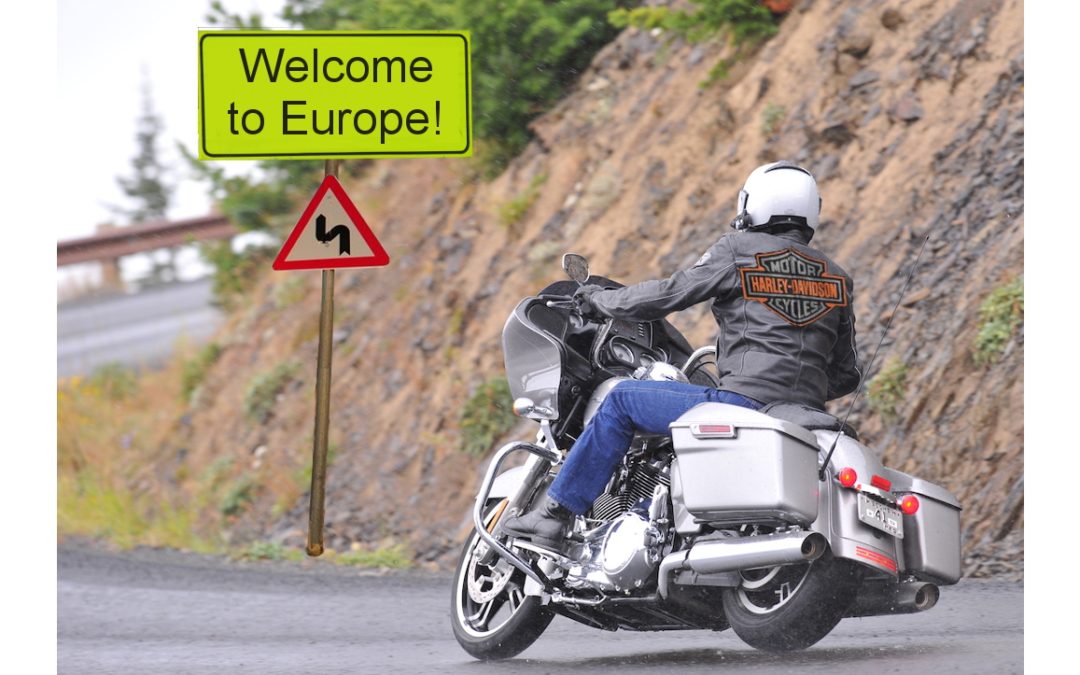
by Adam Hartung | Jun 27, 2018 | In the Swamp, Innovation, Investing, Manufacturing, Transportation, Trends
On Monday, Harley Davidson, America’s leading manufacturer of motorcycles, announced it was going to open a plant in Europe.
Ostensibly this is to counter tariffs the EU will be imposing on its products if imported from the USA. President Trump reacted vociferously on Tuesday, threatening much bigger taxes on Harley if it brings to the USA any parts or motorcycles from its offshore plants in Brazil, Australia, India or Thailand. He also intimated that Harley Davidson was likely to collapse.
Lots of heat, not much light. The issues for Harley Davidson are far worse than an EU tariff.
Harley Davidson has about 1/3 of the US motorcycle market. But in “heavy motorcycles,” those big bikes that are heavier and generally considered for longer riding, Harley has half the market. Which sounds great, until you realize that until the 1970s, Harley had 100% of that market. Ever since then, Harley has been losing share – to imports and to its domestic competitor Polaris.
It was 2006 when I first wrote about Harley Davidson’s big demographic problem. Basically, its customers were all aging. Younger people were buying other motorcycles, so the “core” Harley customer was getting older every year. From mid-30s in the 1980s, by the year 2000 the average buyer was well into their mid-40s. In 2007, I pointed out that Harley had made a stab at changing this dynamic by introducing a new motorcycle with an engine made by Porsche, and a far more modern design (the V-Rod.) But Harley wasn’t committed to building a new customer base, so when dealers complained that the V-Rod “wasn’t really a Harley” the company backed off the marketing and went back to all its old ways of doing business.
Simultaneously, Harley Davidson motorcycle prices were rising faster than inflation, while Japanese manufacturers were not. Thus, as I also pointed out in 2007, it was struggling to maintain market share. Slower sales caused a lay-off that year, and despite the brand driving huge sales of after-market products like jackets and T-shirts, which had grown as big as bike sales, it was unclear how Harley would slow the aging of its customer base and find new, younger buyers. Harley simply eschewed the trend toward selling smaller, lighter, cheaper bikes that had more appeal to more people – and in more markets.
Globally, the situation is far more bleak than the USA. America has one of the lowest motorcycle ridership percentages on the globe. Americans love cars. But in more congested countries like across Europe or Japan and China, and in much poorer countries like India, Korea, and across South America motorcycles are more popular than automobiles. And in those countries Harley has done poorly. Because Harley doesn’t even have the smaller 100cc,200cc, 400cc and 600cc bikes that dominate the market. For example, in 2006 (I know, old, but best data I could find) Harley Davidson sold 349,200 bikes globally. Honda sold 10.3 million. Yamaha sold 4.4 million. Even Suzuki sold 3.1 million – or 10 times Harley’s production.
But, being as fair as possible, let’s focus on Europe – where the new Harley plant is to be built. And let’s look exclusively at “heavy motorcycles” (thus excluding the huge market in which Harley has no products.) In 2006, Harley was 6th in market share. BMW 16%, Honda 15%, Yamaha 15%, Suzuki 15%, Kawasaki 11% and Harley Davidson 9%. Wow, that is simply terrible.
Clearly, Harley has already become marginalized globally. Outside the USA, Harley isn’t even relevant. The Japanese and Germans have been much more successful everywhere outside the USA, and every one of those other markets is bigger than the USA. Harley was simply relying on its core product (big bikes) in its core market (USA) and seriously failing everywhere else.
Oh, but even that story isn’t as good as it sounds. Because in the USA sales of Harley motorcycles has been declining for a decade! Experts estimate that every year which passes, Harley’s customer base ages by 6 months. The average rider age is now well into their 50s. Since Q3, 2014 Harley’s sales growth has been negative! In Q2 and Q3 2017 sales declines were almost 10%/quarter!
As its customer demographic keeps working against it, new customers for big bikes are buying BMWs from Germany – and Victory and Indian motorcycles made by Polaris, out of Minnesota (Polaris discontinued the Victory brand end of 2017.) BMW sales have increased for 7 straight quarters, and their European sales are growing stronger than ever – directly in opposition to Harley’s sales problems. Every quarter Indian is growing at 16-20%, taking all of its sales out of Harley Davidson USA share.
Going back to my 2016 column, when I predicted Harley was in for a hard time. Shares hit an all-time high in 2006 of $75. They have never regained that valuation. They plummeted during the Great Recession, but bailout funds from Berkshire Hathaway and the US government saved Harley from bankruptcy. Shares made it back to $70 by 2014, but fell back to $40 by 2016. Now they are trading around $40. Simply put, as much as people love to talk about the Harley brand, the company is rapidly becoming irrelevant. It is losing share in all markets, and struggling to find new customers for a product that is out-of-date, and sells almost exclusively in one market. Its move to manufacture in Europe is primarily a Hail-Mary pass to find new sales, paid for by corporate tax cuts in the USA and tariff tax avoidance in Europe.
But it won’t likely matter. Like I said in 2006, Harley Davidson is a no-growth story, and that’s not a story where anyone should invest.

by Adam Hartung | Mar 20, 2018 | Investing, Leadership, Lock-in, Marketing, Strategy, Transportation
Do you remember the songs, and videos, from 2008 “United Breaks Guitars?” After United Airlines destroyed musician Dave Carroll’s guitar he chronicled the months-long journey he took trying to replace it. In the end, United told him “F**k you” as customer service blew him off completely. He went on to make a few million dollars with his songs and parody about the horrible experience. Because so many people felt they were abused like Mr. Carroll.
“United Breaks Guitars” was a hit because so many people related to the terrible customer experience on United. 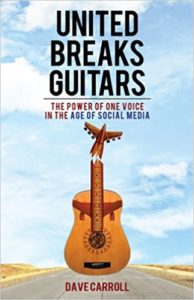 “The Unfriendly Skies” was the motto of customers, mocking the airlines “Friendly Skies” ads. It was clear that by 2008 United did not care about customers. Moving headlong to constantly lower operating costs, United built a culture that focused solely on efficiency, leading to terrible customer service, unhappy customers and employees that were a lot more worried about being yelled at by their bosses for not cutting costs than creating any customer satisfaction.
“The Unfriendly Skies” was the motto of customers, mocking the airlines “Friendly Skies” ads. It was clear that by 2008 United did not care about customers. Moving headlong to constantly lower operating costs, United built a culture that focused solely on efficiency, leading to terrible customer service, unhappy customers and employees that were a lot more worried about being yelled at by their bosses for not cutting costs than creating any customer satisfaction.
Things certainly haven’t changed. In 2017, United ejected a 69 year old physician from a plane, breaking his nose, knocking out his teeth and giving him a concussion. That created an uproar. Yet within a week United killed the world’s largest bunny rabbit in an airplane holding bin. But, even worse, last week United actually killed a puppy by forcing it be placed in an overhead bin. At least the dog United sent on a 1,000 mile unexpected flight to Japan survived, and the interviewed owner said he felt lucky the airline hadn’t killed his pet. Of course United refunded their money – which as you can imagine was a slap in the face to all these people who were so abused.
Unfortunately, United is just the worst of a bunch of bad airlines. Customer service really isn’t any better on Delta, American, JetBlue or Southwest. Saying these other airlines are better is just picking out a less heinous member of the Khmer Rouge Army.
STRATEGY MATTERS
This all goes back to deregulation. When President Carter allowed the airlines to charge as they like the industry really had no idea what it was going to do. There was chaos for years. But eventually consolidation kicked-in, and cutting cost was the only thing all 3 majors agreed upon. Buy more market share, as opposed to winning it with customer service, then slash the costs. This did the wonderfulness of leading all of them to file bankruptcy! Some twice! What a grand industry strategy!
 Then Chairman of American Airlines received Wall Street Journal front-page coverage for realizing people weren’t eating their olives in first class, so he ordered olives removed from the first class meals. He was cheered for saving $100K. But what folks missed was that he, and his peers leading the airlines, were systematically trying to figure out “how do we offer the least possible service.” By focusing on a strategy of lowering cost, and being doggedly determined in that strategy, soon nothing else mattered.
Then Chairman of American Airlines received Wall Street Journal front-page coverage for realizing people weren’t eating their olives in first class, so he ordered olives removed from the first class meals. He was cheered for saving $100K. But what folks missed was that he, and his peers leading the airlines, were systematically trying to figure out “how do we offer the least possible service.” By focusing on a strategy of lowering cost, and being doggedly determined in that strategy, soon nothing else mattered.
Today, there are no free meals in coach, and terrible meals in first class. Management angered employees into strikes and multi-year negotiations, beating down compensation and eliminating benefits leading to unhappiness so bad that in 2010 a Jet Blue flight attendant pulled the emergency exit and jumped out of the plane as he quit.
So, all the airlines in America stink. And, many domestic airlines in Europe, such as Ryan Air, have followed suit. The execs keep saying “all customers care about is price.” They use that excuse to create a culture so hostile to employees, and customers, that pretty soon employees are beating up customers and killing family pets (after charging extra to take the pet on the plane) and actually not caring.
Employees have become gestapos for the leadership – which has created a culture in which nobody wins. So flight attendants do as little as possible, because they don’t care about customers any more than leadership does. In 2017, a JetBlue attendant threw a family off flight because their toddler kicked the seat. When a woman complains about a child in seat next to her a Delta attendant throws her off the plane. And just last week when a 2 year old cries during boarding a Southwest attendant throws the child and her father off the plane.
Deregulation led to an oligopoly. Now, customers have no choice. Some of us fly almost every week on business, and it is pure hell. Nobody we deal with, from TSA to airport vendors to airline staff like customers. The culture has become “I’m abused, so you will be abused.” To fly is to succumb to being obsequious to ALL employees in your effort to not anger anyone, for fear they will deny you service. Or, worse, beat you up or kill your pet. But, honestly, there is nothing customers can do about it.
STRATEGY MATTERS
The leadership of the airlines, lacking regulation, implemented a strategy of “be low cost.” The result was creating a culture where employees routinely abuse customers in the process of trying to save a few dimes. If the next Mark Zuckerberg, Elon Musk or Reed Hastings showed up, do you think HR would hire them? Would the Board of Directors, so focused on the wrong strategy, consider any of them as CEO? The wrong strategy has led to the ruination of an entire industry, miserable employees, unhappy customers and marginal returns. It is a terrible culture.
So what is your strategy? Is your strategy creating the culture you want? Are you headed toward happy customers who want more of your product or service, and create growth? Or are you letting your lack of a forward-thinking strategy default you into operational cost cutting, and the movement toward a culture of misery that drives away employees, vendors and eventually customers?
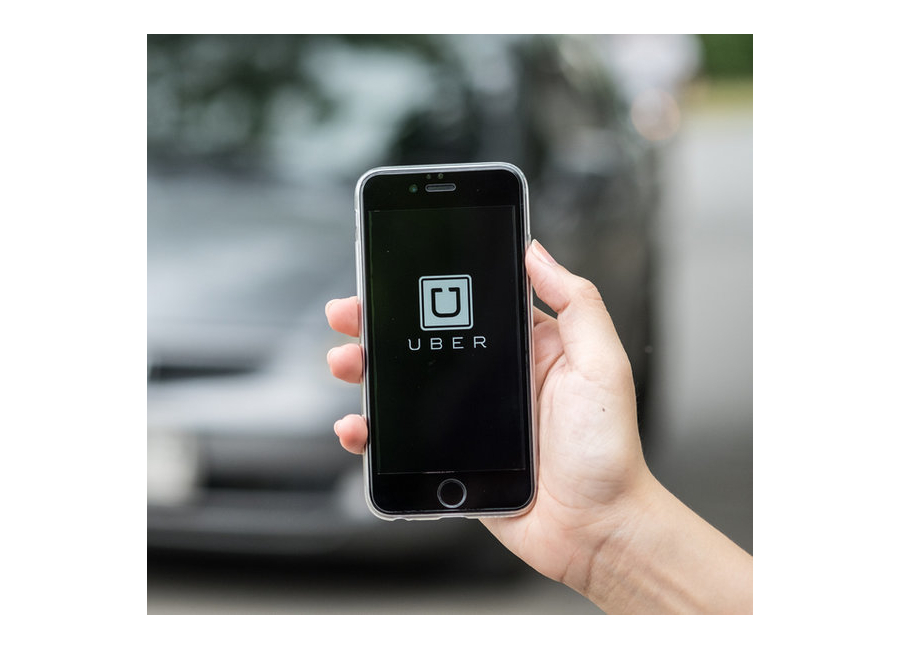
by Adam Hartung | Aug 24, 2017 | Boards of Directors, Leadership, Transportation
We learned last week that Jeff Immelt is a front-runner to be the next CEO of Uber. There are many reasons to be concerned about this possibility.
Uber has received nothing but bad news for a while now:
Amidst these scandals, Uber’s big investors are
writing down the value of their Uber holdings by 15%. After pushing the board for new leadership, and restructuring, it appears investors are losing faith in the company.
This puts the board in the hot seat. Investors want a new CEO that will eliminate the scandals. They want stability at the company. Reeling from so much bad news, they want someone atop the organization who will “right the ship” with “a steady hand on the tiller” so they can regain confidence. Amidst the turmoil, and the need to please investors, an executive who spent 35 years at GE, and over a decade in the top job, probably sounds like a good candidate. He’s known as a stable guy, numbers-focused, genteel, well-schooled (Harvard MBA) and above all “seasoned.”
But the stakes are incredibly high. Picking the wrong person at this moment could well lead to a horrible long-term outcome. While meeting short-term needs sounds like the #1 goal right now, for Uber to succeed means putting someone in the CEO job who can guide the tech company through a decade or more of tough decisions in a fast-paced market. Other boards have suffered horribly from making this decision hurriedly and poorly.
Remember the CEO turmoil at Yahoo:
- Yahoo was an early leader on the web, first in search, content distribution, on-line sales and advertising under CEO Tim Koogle from 1995-2001.
- Due to controversies (remember when he sold Nazi memorabilia?) he was replaced by proven media exec (25 years at Warner Brothers) Terry Semel from 2001-2007. He’s the one who missed the opportunities to buy Google and Facebook.
- Worried the company needed more pizzazz to catch leapfrogging competitors, the board brought back founder Jerry Yang for 17 months (2007-2008).
- When sales didn’t improve the board brought in brash, blunt speaking Carol Bartz, CEO of Autodesk, to turn around the company (2009-2011.) After months of cost-cutting but no sales improvement, she was gone.
- In January 2012 the board hired the President of Paypal, Scott Johnson, as CEO. But 5 months later he was fired for lying on his resume.
- Amidst a need to find someone to lead the company long-term, in 2012 the board hired Google darling Marissa Mayer as CEO. She left when Yahoo dissolved.
Or how about Twitter:
- From 2007-2008 Jack Dorsey was the founder who drove growth and early funding.
- Dorsey was replaced by Evan Williams (2008-2010) who was to supply a steadier, more seasoned hand at the top.
- Looking to grow and go public, the board replaced Williams with Dick Costolo (2010-2015). Although the IPO went well, lack of investor enthusiasm led to stock weakness.
- In 2015 Costolo was replaced by the returning Dorsey. He supposedly would rejuvenate the company. Since his return the stock has dropped about 50% amidst concerns regarding insufficient user and revenue growth.
But this is not a new problem in tech. Remember the CEO litany at Apple:
- Apple’s first CEO (1977-1981) was Michael Scott from National Semiconductor, brought in to support the inexperienced Steve Jobs and Steve Wozniak. But he was unable to get along with the founders, and built a reputation of firing those he didn’t like.
- Mike Markkula, Apple’s early investor and 3rd employee, replaced Scott as CEO from 1981-1983.
- Hoping to put someone with a better pedigree, more big-company experience and a steadier hand in the top job, Markkula hired John Sculley (former Pepsi CEO) to Apple’s top job in 1983. Markkula agreed with Sculley to fire the mercurial Jobs in 1985. Sculley remained CEO until 1993, when he was removed as Apple lost the war with Microsoft for corporate desktops and sales tanked. Sculley, the much heralded, experienced corporate leader, ended up ranked the 14th worst CEO of all time by Conde Nast Portfolio.
- The board replaced him with insider Michael Spindler (1993-1996) who tried to sell Apple to IBM, Sun and Philips, but failed.
- Spindler was replaced by Gil Amelio (1996-1997) former CEO of National Semiconductor, who was considered the kind of mature, dedicated leader Apple needed. As Apple shares slumped to all time lows, he bought Jobs-owned NeXt.
- Jobs (CEO 1997-2011) succeeded in convincing the Board to fire Amelio. Jobs subsequently fired the board. The rest is well documented.
Jeff Immelt is no Steve Jobs
Clearly, Uber’s board needs to find a Steve Jobs. And by all accounts, for all his skills, Jeff Immelt is NOT a Steve Jobs. During his tenure as CEO of GE things might have been boring, but the company also lost a third of its revenues, and a third of its market cap. After more than a decade of stagnation, Immelt was forced out. It is hard to imagine he is the right person to guide Uber, a high-tech company in a fast changing marketplace filled with techie employees who want a culture of rapid growth with opportunities to build fortunes in company equity. To maintain its value Uber needs to keep growing at 20%+/year, and Immelt has no experience creating that sort of revenue success.
So what should the board look for? Last summer Chris Zook and James Allen of Bain & Co. published their treatise on how to lead high growth companies The Founder’s Mentality – How To Overcome the Predictable Crises of Growth . I interviewed Chris Zook last year, and he offered great insights that would be incredibly valuable for the Uber board now:
- Being great is hard. Most companies are focused on going from mediocre to good, far from going from good to great. Uber is the undisputed champion in ride-sharing today. The leader must be unassailable as a visionary. Someone who understands how to build a GREAT company. The last CEO may have been problematic, but he built Uber – a tremendous business success. The new leader has to be on a par with other leaders of companies considered great by the employees (and investors) or he will not be respected, and there will be more problems, not fewer.
- “Next Generation CEOs” (as Zook calls them) are flexible thinkers who can figure out the hidden core, and build on it. The incoming CEO of Marvel realized its core was story telling, not comics, and directed the company into films and other growth venues. Jobs realized Apple was more than the Mac, and tied the company to offering easy-to-use products that fit emerging mobile needs. Uber’s next CEO has to go deeper than the scandals and obvious business model to understand what made Uber the leader, and expand on that nugget of strength to keep the company growing, and beating competitors. (Software for the gig economy? Time sharing assets?)
- Blockages are what kill companies. Most big-company CEOs are great at creating organizational blockages to create stability. They tend to be numbers first, customers and technology second. They put in place middle managers with the primary job of stopping behaviors that could be problematic. They instill “no” in order to stop mistakes. Do not ever forget the Sculley/Apple experience. The next Uber CEO has to be willing to operate in a culture with few barriers, direct access from the bottom employee to the CEO, and the ability to move quickly to deal with problems rather than attempting to eliminate the possibility of problems.
- The CEO has to be willing to make big bets. Today markets move fast. Leaders have to project trends, understand where customers are headed and place big bets that keep the company on top. Think about Bezos pushing Amazon to implement Prime, and buying Whole Foods. Think about Jobs directing Apple’s massive bet on mobile and the iPod. Think about Reed Hastings making the big bet at Netflix on streaming, and more recently on original content. To be a successful leader today of a growth company is not for the timid, nor for those who want to make small, progressive bets over time. It requires vision, the willingness to make big bets and the ability to convince your employees, your board of directors and your investors to buy into that bet.
The Uber board is apparently a bit tired of their search. Perhaps that’s because they aren’t looking for the right kind of person. As Mr. Zook told me, you rarely find leaders with a “Founder’s Mentality” through a search firm. You find them already competing, offering insight, doing new things in situations where the competition is intense. Like Jobs was at Pixar, and NeXt.
The right leader is out there – we’ve seen the type in companies mentioned here, and others like Google and Facebook. But you have to search for them intensely. What seems very, very unlikely is that Mr. Immelt is “the right man for the job” at Uber today.
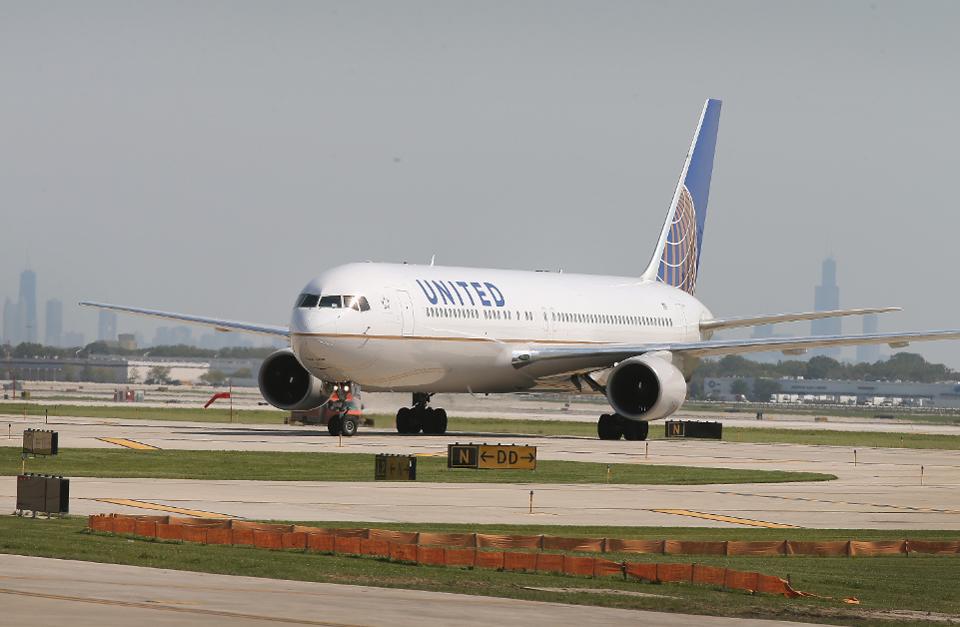
by Adam Hartung | Apr 10, 2017 | Leadership, Transportation
Most readers of this column will already know that on Sunday, April 9, 2017 United Airlines forcibly removed a 69-year-old passenger from a flight, over his objections. United employees had Chicago Aviation Police board the plane, grab the passenger (who had a valid boarding pass) and drag him off the plane as if he were a hijacker. In the process the police banged his head on an armrest, leaving him battered and bloodied. When the passenger returned to the plane the police again forcibly manhandled him, restrained him and took him off the plane strapped onto a stretcher.
All so the airline could board a flight attendant that needed to reach the plane’s destination in order to make her next working flight. In other words, United’s front line management chose to not only inconvenience a paying customer, but physically abuse that customer so the airline would maintain its operating crew schedule.
After, the company CEO Oscar Munoz apologized for “re-accomodating” customers. Since about 40,000 people are “re-accomodated” — or bumped from oversold flights — annually, the CEO’s apology covers the 3,675 United customers bumped in 2016. But, he did not apologize for United employees taking action that directly led to the physical abuse of a customer.
Most of us would not believe this story if it were part of a fictional movie. How could it be possible for a front-line employee to think it is acceptable to forcibly eject a paying customer already on the plane?How could it be possible that a CEO would be so uncaring as to not apologize for a clear, horrific lapse in judgement by someone on his management team? Whatever the situation, every action taken by United merely served to make the situation worse. How could a company so large be so mismanaged — from the bottom to the top?
Blame “Operational Excellence”
That is the problem with CEOs, and leadership teams, that focus on “operational excellence” as a strategy. They become so focused on efficiency, cost cutting and business operations that they forget about customers — or anything else. All that matters is keeping the business operating, while trying to keep costs as low as absolutely possible. Management, from bottom to top, is rewarded for operational performance, while all other metrics are ignored. Including customer satisfaction.
In “operationally excellent” companies the focus on low costs is driven by a desire to keep prices low. The perception among management is that customers care only about price, so there is no reason to track anything other than costs. If they keep costs (and prices) low customers will be happy, regardless of anything else in the customer’s experience.
United Has Abused Customers For Years
This is not the first time United has had this kind of problem. In 2009 Canadian musician Dave Carroll became a sensation after producing a series of YouTube videos that chronicled his experience after United baggage handlers destroyed his guitar. The baggage handlers clearly did not care about his guitar. Nor did the gate agents, the baggage department or the customer service department. After many, many calls United personnel simply decided Mr. Caroll’s broken guitar would not be compensated — even though they broke it — and he should just “get over it.”
In 2013, United came in dead last in the Airline Quality Rating. United’s response (as I detailed in a 2013 Forbes column) was simply that “they did not care.” Quite literally, lowering cost was more important that being dead last in customer satisfaction.
In 2016, United fired its CEO after discovering he was bribing government officials to obtain favorable treatment at New Jersey and New York airports. The pressure to lower cost in the “operationally excellent” strategy was so paramount that judgement falters not only at low levels, but all the way up to the CEO.
Operational Excellence Hurt WalMart As Well As United
United isn’t alone in its failures due to operational excellence focus. WalMart has been the victim of bad management judgment for the same reason. Remember in July, 2014 when a WalMart truck driver who had been awake for 24 hours hit a car in New Jersey killing comedian James McNair and seriously injuring comedian Tracy Morgan? That driver had been on the road longer than he should, with insufficient sleep, in his effort to meet operational deadlines – and was charged with aggravated manslaughter, second-degree vehicular homicide and 8 counts of third-degree aggravated assault charges.
This happened just two years after investors learned WalMart was accused of bribing Mexican government officials to keep costs low there — bribery that caused the departure of the WalMart Mexico president, and eventually Walmart’s CEO. In both cases, at the top and at the front line, judgment was impaired by leadership’s focus on operational efficiency.
Unfortunately, too many business leaders put too much energy into operational excellence. They focus on cutting costs, improving operations, and trying to offer low price as the primary reason customers should do business with them. They quickly lose sight of customer needs, wants and wishes as they overly simplify their business’ offering into price. And this leads to bad decision-making all the way from the CEO to the front line manager — who will drive customers away in his effort to meet operational metrics and goals.
Once Locked In Operational Excellence Is A Hard Strategy, And Culture, To Change
United clearly needs a cultural change. But will it make one? Given the CEO’s reaction to this incident, it appears highly unlikely. Locked in to viewing his company operationally, Munoz appears to have lost common sense when it comes to customers – and running the business in a way that can lead to long-term profitability. Herb Kelleher, founder of Southwest Airlines, and Richard Branson, founder of Virgin Airlines, knew there was more to a successful airline than flight schedules and cheap fuel purchases. So far United’s leadership has failed to see the obvious.
by Adam Hartung | Jun 19, 2009 | Boards of Directors, Books, Defend & Extend, eBooks, In the Whirlpool, Leadership, Lifecycle, Lock-in, Transportation
Of all the companies that typified America’s rise as an industrial superpower, none was more successful than General Motors.
What happened? Why has it fallen so far? GM at its biggest boasted some 600,000 well-paid employees. It will be left with something like 60,000 after it emerges from bankruptcy. How did that happen? Why did its stock price tumble from $96 per share at its height to 80 cents recently? Why did its market share shrink from one out of every two cars sold to less than one in five last quarter?
And thus begins the new ebook about the fall of GM. In 1,000 words this ebook covers the source of GM’s success – as well as what led to its failure. And what GM could have done differently – as well as why it didn’t do these things. Read it, and share it. Let folks know about it via Twitter. Post to your Facebook page and groups, as well as your Linked-in groups. As markets are shifting the fate of GM threatens all businesses. Even those that are following the best practices that used to make money. Let’s use the story of GM — and the costs its bankruptcy have had on employees, investors, vendors and the support organizations around the industry as well as government bodies — as a rallying cry to help turn around this recession and get our businesses growing again!
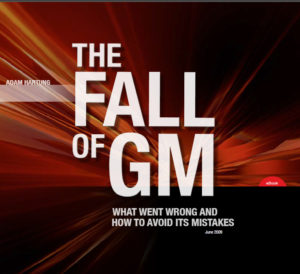
Download Fall of GM

 Both Radio Flyer and Harley-Davidson have responded to trends by introducing electric personal transportation products. Both also have loyal core customer segments and strong brand awareness in non-customer segments. The new products allow both companies to launch to existing customers which is the lowest risk choice because the segments are well-known. From there, the brands can expand to new customer segments via word-of-mouth, visibility and ad campaigns. This follows the Ansoff matrix from Current Market/New Product to New Market/New Product.
Both Radio Flyer and Harley-Davidson have responded to trends by introducing electric personal transportation products. Both also have loyal core customer segments and strong brand awareness in non-customer segments. The new products allow both companies to launch to existing customers which is the lowest risk choice because the segments are well-known. From there, the brands can expand to new customer segments via word-of-mouth, visibility and ad campaigns. This follows the Ansoff matrix from Current Market/New Product to New Market/New Product.





 “The Unfriendly Skies” was the motto of customers, mocking the airlines “Friendly Skies” ads. It was clear that by 2008 United did not care about customers. Moving headlong to constantly lower operating costs, United built a culture that focused solely on efficiency, leading to terrible customer service, unhappy customers and employees that were a lot more worried about being yelled at by their bosses for not cutting costs than creating any customer satisfaction.
“The Unfriendly Skies” was the motto of customers, mocking the airlines “Friendly Skies” ads. It was clear that by 2008 United did not care about customers. Moving headlong to constantly lower operating costs, United built a culture that focused solely on efficiency, leading to terrible customer service, unhappy customers and employees that were a lot more worried about being yelled at by their bosses for not cutting costs than creating any customer satisfaction. Then Chairman of American Airlines received Wall Street Journal front-page coverage for realizing people weren’t eating their olives in first class, so he
Then Chairman of American Airlines received Wall Street Journal front-page coverage for realizing people weren’t eating their olives in first class, so he 
